A) P = ATC.
B) P > AVC.
C) P = MC.
D) P > ATC.
Correct Answer

verified
Correct Answer
verified
Multiple Choice
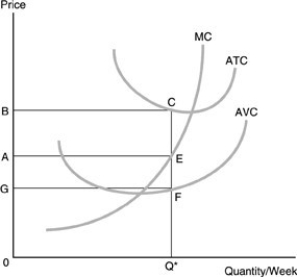 -Refer to the above figure. If the market price is equal to A, which statement can be made about profits?
-Refer to the above figure. If the market price is equal to A, which statement can be made about profits?
A) Profits are positive and equal to BCEA.
B) Profits are positive and equal to BCFG.
C) Profits are negative and equal to BCEA.
D) Profits are negative and equal to GFQ0. ![]()
Correct Answer

verified
Correct Answer
verified
Multiple Choice
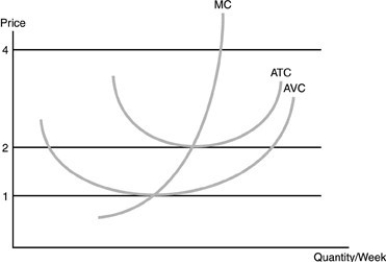 -Refer to the above figure. Profits will be negative
-Refer to the above figure. Profits will be negative
A) when the price equals $2.
B) when the price is above $2.
C) when the price is below $2.
D) only when the price equals $1.
Correct Answer

verified
Correct Answer
verified
Multiple Choice
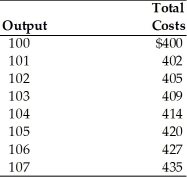 -Refer to the above table. If the price is $3 the maximum profit this firm could earn is
-Refer to the above table. If the price is $3 the maximum profit this firm could earn is
A) $99.
B) $306.
C) -$100.
D) -$99.
Correct Answer

verified
Correct Answer
verified
Multiple Choice
Economists generally assume that firms attempt to maximize
A) total revenue.
B) sales.
C) marginal revenue.
D) total economic profits.
Correct Answer

verified
Correct Answer
verified
Multiple Choice
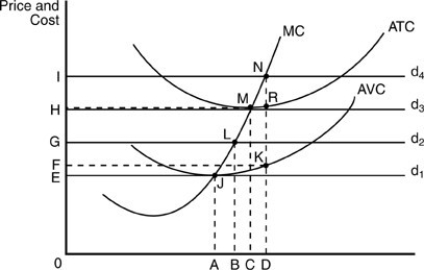 -If the firm in the above figure produces output level D, it incurs an average fixed cost of production equal to the distance
-If the firm in the above figure produces output level D, it incurs an average fixed cost of production equal to the distance
A) DK.
B) RN.
C) JL.
D) KR.
Correct Answer

verified
Correct Answer
verified
Multiple Choice
Which of the following is always TRUE in the short run for a perfectly competitive firm that is maximizing economic profits?
A) P = d = MR = MC = AVC
B) P = d = MR = MC
C) P = d = MR = Q
D) MR = MC = Q
Correct Answer

verified
Correct Answer
verified
Multiple Choice
In a perfectly competitive market, positive economic profits act to
A) attract new entrants into the industry.
B) drive potential competitors away from the industry.
C) prevent reinvestment on the part of firms within the industry.
D) signal resource owners elsewhere not to invest their capital in this industry.
Correct Answer

verified
Correct Answer
verified
Multiple Choice
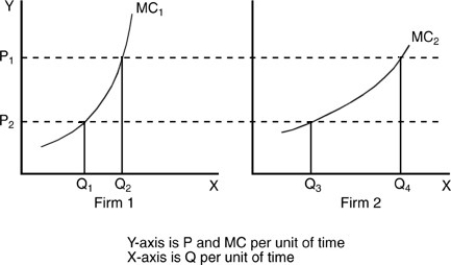 -In the above figure, assuming Firm 1 and Firm 2 are the sole producers in the industry, the industry quantity supplied at price P1 is equal to
-In the above figure, assuming Firm 1 and Firm 2 are the sole producers in the industry, the industry quantity supplied at price P1 is equal to
A) Q1 + Q2.
B) Q1 + Q3.
C) Q2 + Q4.
D) Q4 - Q2.
Correct Answer

verified
Correct Answer
verified
Multiple Choice
The vertical distance between the horizontal axis and any point on a perfect competitor's demand curve measures
A) total cost.
B) total revenues.
C) product price, marginal revenue, and average revenue.
D) supply curve for the product.
Correct Answer

verified
Correct Answer
verified
Multiple Choice
 -Refer to the above figure. Profits will equal zero
-Refer to the above figure. Profits will equal zero
A) when the price equals $1.
B) when the price equals $2.
C) when the price equals $4.
D) at prices between $1 and $2.
Correct Answer

verified
Correct Answer
verified
Multiple Choice
Which is always TRUE at a firm's profit-maximizing rate of production?
A) Total Revenue = Total Costs
B) The total revenue curve lies below the total cost curve.
C) Marginal Revenue > Marginal Cost
D) Marginal Revenue = Marginal Cost
Correct Answer

verified
Correct Answer
verified
Multiple Choice
Malfeasance at Enron, a Houston-based energy firm, led to overstatement of revenues by almost $92 billion. As Enron closed its operations, U.S. energy prices remained stable. This may have been evidence that
A) Enron could charge whatever price it wanted to for energy.
B) there was lack of any competition, so Enron was the winner.
C) there is a competitive market in energy distribution in the United States.
D) the accounting profession needs to review its policies quickly.
Correct Answer

verified
Correct Answer
verified
Multiple Choice
The short-run break-even price
A) is the price at which the firm's current liabilities are paid off.
B) is the price at which a firm's total revenues equal total costs.
C) occurs at the output at which the firm yields a below normal rate of return.
D) occurs at the output at which the firm yields a positive economic profit.
Correct Answer

verified
Correct Answer
verified
Multiple Choice
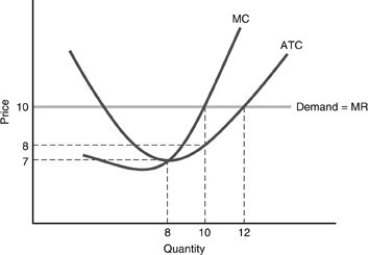 -In the above figure, what is the profit at the profit-maximizing output level?
-In the above figure, what is the profit at the profit-maximizing output level?
A) $70
B) $2
C) $20
D) $10
Correct Answer

verified
Correct Answer
verified
Multiple Choice
If the wage rate increases and firms in a perfectly competitive industry are hiring labor, then
A) the firms will quit using labor.
B) profits will increase.
C) market supply will decrease.
D) market price will decrease.
Correct Answer

verified
Correct Answer
verified
Multiple Choice
What is the shape of the long-run supply curve in an increasing-cost industry?
A) horizontal
B) inverted U-shape
C) downward sloping
D) upward sloping
Correct Answer

verified
Correct Answer
verified
Multiple Choice
Suppose a perfectly competitive firm faces the following short-run cost and revenue conditions: ATC = $6.00; AVC = $4.00; MC = $3.50; MR = $3.50. The firm should
A) increase output.
B) increase price.
C) remain at the same position.
D) shut down.
Correct Answer

verified
Correct Answer
verified
Multiple Choice
In a perfectly competitive market, the average revenue curve of a firm is
A) the same as its total revenue curve.
B) the same as its demand curve.
C) the same its economic profits.
D) the difference between its total revenue curve and its marginal revenue curve.
Correct Answer

verified
Correct Answer
verified
Multiple Choice
A firm in a perfectly competitive industry is a
A) price taker.
B) quantity taker.
C) profit maker.
D) price maker.
Correct Answer

verified
Correct Answer
verified
Showing 321 - 340 of 432
Related Exams